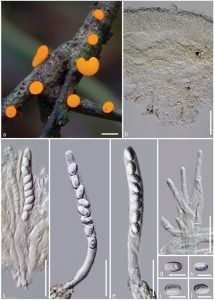Acervus stipitatus Ekanayaka, Q. Zhao & K.D. Hyde, sp. nov., Index Fungorum number: IF 552370
Etymology: The specific epithet stipitatus refers to the apothecial type.
Holotype: CHINA, Yunnan Province, Xishuangbanna, buffer zone of the Nabanhe National Nature Reserve (NNNR), N22◦04ʹ–22◦17ʹ; E100◦32ʹ–100◦44ʹ, 30 August 2015, S.C Karunarathna (MFLU 16–0607).
Diagnosis: Apothecia stipitate, discoid, deep yellow. Receptacle concave. Hymenium hyaline to yellowish. Paraphyses subcylindrical. Asci unitunicate inoperculate with 8 ellipsoid ascospores.
Description: Saprobic on dead stems. Sexual morph: Apothecia 3–8 × 3–5 mm (x̄ =5.2 × 3.8 μm, n=10) arising singly, stipitate, discoid, deep yellow (4A8) when fresh. Receptacle concave, disc and margins are yellow to orange when fresh. Hymenium hyaline to yellowish. Ectal excipulum 90–120 μm (x̄ =106.2 μm, n=10) composed of large, thin-walled, hyaline cells of textura globulosa to angularis and medullary excipulum 130–180 μm (x̄ =168.6 μm, n=10) composed of hyaline cells of textura intricata mixed with textura angularis. Paraphyses 3–5 μm (x =3.6 μm, n=20) wide at the middle, hyaline, aseptate, subcylindrical. Asci 120–15 × 7–10 μm (x̄ =140.2 × 9.1 μm, n=30) (length and the width at the middle) unitunicate, inoperculate, cylindrical, long pedicellate, non-amyloid. Ascospore 9–11 × 6–8 μm (x̄ =10.2 × 6.7 μm, n=40), uniseriate, ellipsoid, uniguttulate, hyaline, aseptate, smooth, thin-walled. Asexual morph: Undetermined.
Habitat and Distribution: Solitary on soil with decaying litter under trees, Yunnan Province, China.
Material examined: CHINA, Yunnan Province, Xishuangbanna, buffer zone of the Nabanhe National Nature Reserve (NNNR), N22◦04ʹ–22◦17ʹ; E100◦32ʹ–100◦44ʹ, 30 August 2015, S.C Karunarathna (MFLU 16–0607, holotype).
Notes: Acervus stipitatus is distinguished by stipitate, discoid orange yellow apothecia with ellipsoid, uniguttulate ascospores. Acervus stipitatus is morphologically similar to A. xishuangbannicus (Zhuang & Wang 1998), but they differ in ascomatal colour and spore shape, size and number of guttules present. The spores of A. stipitatus are ellipsoid, uniguttulate and smaller (9–11 × 6–8 μm) and spores of A. xishuangbannicus are broadly ellipsoid, biguttulate and larger (12.5–13.5 × 9–10 μm).

Fig 3. Morphology of Acervus stipitatus (holotype). a. Apothecia on dead stem, b. Hymenium and excipulum in vertical section, c–e. Inoperculate asci, f. Hyaline paraphyses, g–j. Hyaline ascospores. Scale bars: a=5 mm, b=100 μm, c–f=30 μm, g–j=10 μm.
